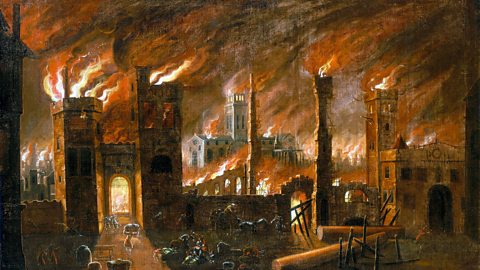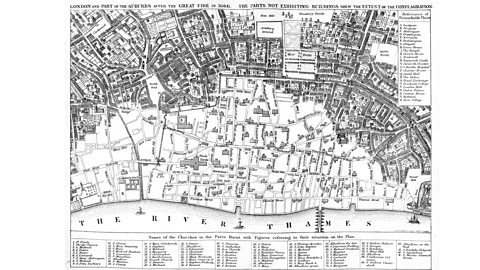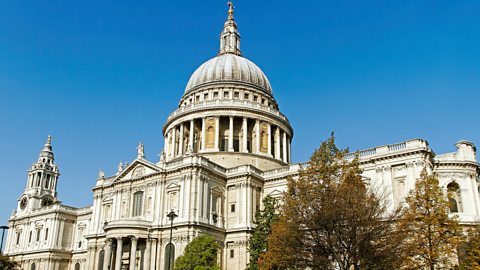Key points
- In the early hours of 2 September 1666, a fire started in London. Over the course of a few days the fire spread across the city, causing widespread destruction.
- The causes of the fire and why it was able to continue burning for many days give an insight into life in London at the time.
- Samuel PepysA naval administrator at the time of the Great Fire of London. He kept a diary from 1660 - 1669, which gives useful first-hand account of the events of the fire.and John Evelyn provided a detailed account of the fire in their diaries.
- The aftermath of the fire brought both positive and negative impacts.

The stones of St Paul’s flew like grenades, the lead melting down the streets in a stream. And the very pavements glowing with fiery redness, so as nor house nor man was able to tread on them.
- An excerpt from the diary of the writer and gardener John Evelyn
What started the Great Fire of London?
The Great Fire of London started in the heart of the city in a bakery on Pudding Lane in the early hours of Sunday 2 September 1666. The baker, Thomas Farriner, woke to the smell of smoke - a fire was raging downstairs in the bakery. Before the government set up an organised effort to put the fire out people were trying to extinguish it with buckets of water they got from the River ThamesA river that runs through London from west to east..
The fire raged on for around five days, destroying over half of the city, with smaller fires continuing to burn until the following Sunday. In many parts of the city the ground was too hot for people to walk on for several days after the fire.
Did people at the time believe the fire was an accident?
Many people at the time didn’t believe the fire was an accident. They suspected a foreign plot, or a Catholic plot.
Shortly after the fire died down, a number of foreign people were attacked. One person, a Frenchman named Robert Hubert was arrested on suspicion of starting the fire, and was found guilty and hanged. However, Hubert could not have had anything to do with the fire because he wasn’t in the country when the fire began. His conviction and execution shows how keen people were at the time to find someone to blame.
The Lord Mayor's response to the fire
At first, very few people thought that the fire was serious. The Lord Mayor of London, Thomas Bloodworth, was angry when he was woken up and taken to see the fire. He was asked to give permission to destroy houses to stop the fire spreading, but he refused. He was confident that the fire could easily be extinguished and returned home to bed.
Samuel Pepys was highly critical of the Mayor’s response to the fire, recording in his diary that Bloodworth was ‘a silly man I think, as his conduct during the Great Fire fully proved.’
Who was Samuel Pepys?
- Samuel Pepys lived in London at the time of the fire.
- In 1666 he was working for the Navy Board, which was a key government department.
- Pepys had started writing a diary from the start of 1660.
- His diary gives us a detailed account of the events of the fire and the actions the authorities took to deal with it.
- As the fire spread, Pepys famously wrote about burying some of his possessions to protect them from the fire, including some Parmesan cheese!
Why did the fire spread so quickly?
In the late hours of Monday evening and the early hours of Tuesday morning the fire worsened. People began to flee from the fire rather than staying to try and put it out. There were lots of reasons that combined to make it easy for the fire to spread quickly and destroy large parts of the city.
How was the fire able to spread so quickly?
In 1666 the nature of the buildings and the weather conditions made a significant contribution to the spread of the fire.
- Buildings were made mostly out of wood
- Buildings were built veryclose together in the crowded city centre
- A hot and dry summer meant buildings easily caught fire
- A strong wind fanned the flames
- There was also no organised fire brigade in 1666
All of these factors meant the fire spread quickly, making it difficult to bring under control.
Attempts to stop the fire
As the fire raged on into Tuesday 4 September, St Paul’s Cathedral burned down. It took around 30 minutes after the building caught fire for the lead roof to melt. Walking through London after the fire had ended, Samuel Pepys described St Paul’s as a ‘miserable sight… with all the rooves fallen.’
King Charles II takes action

King Charles II ordered the use of fire breaks he insisted that houses in the path of the fire should be pulled down or blown up. He hoped that this would stop the fire spreading more widely and would also protect the Tower of LondonA castle in central London. The castle is a royal palace where the Crown Jewels have been stored since 1661. where the city’s supply of gunpowder was kept.
At first he ordered the Lord Mayor to pull houses down, to form fire breaks, but this didn't work. By Wednesday 5 September he then had whole rows of houses blown up using gunpowder. This created big enough spaces to stop the fire from spreading from building to building. The fire breaks worked.

According to Samuel Pepys diary, what was Thomas Bloodworth's response to the king's orders?
Samuel Pepys recorded the response of the Lord Mayor to the events of the fire in his diary on September 2nd, 1666. This is a simplified excerpt:
I told the King and Duke of York (the King’s brother, James) what I saw, and that unless his Majesty ordered houses to be pulled down, nothing could stop the fire. They were very troubled, and the King commanded me to go to the Lord Mayor (Sir Thomas Bludworth), and command him to spare no houses, but to pull down before the fire every way. The Duke of York told me to tell him, that if he needed any more soldiers, he could have them … At last, I met the Lord Mayor in Canning Street. In response to the King's message, he cried, "Lord! what can I do? I am spent - people will not obey me. I have been pulling down houses; but the fire overtakes us faster than we can do it."
The effects of the Great Fire
The official records show that only six people died from the Great Fire. However, some historians suggest that it is possible that hundreds of people were killed but their bodies were never found because they were trapped under the fire. Thousands of people were made homeless after the fire and so many fled the city, leading to many more deaths due to poverty and exposure to the cold.

Camps were set up on the outskirts of the city for the many people who were made homeless after their homes were destroyed or damaged in the fire. The reduced numbers of houses following the fire meant that rent costs increased in the areas that had not been burned, many people could not afford the increase and were also made homeless.
The rebuilding of London

The Great Fire of London was a disaster that saw around 436 acres of the city destroyed. In planning the rebuilding of the city, careful consideration was given to how a similar catastrophe could be avoided in the future.
In response to the destruction King Charles II had architects put plans together to rebuild London.
Before the fire, King Charles II had asked the architect Christopher Wren to draw up some designs for the redevelopment of St Paul’s cathedral. Now that the church was left in ruins, Wren came up with several designs for the cathedral to be rebuilt. The now famous dome-shaped roof was in the chosen design and the cathedral was fully rebuilt by 1711.

The Great Fire of London picture quiz
Preventing another fire
The Great Fire of London was a horrible experience for the people who had lost family and friends. Many people also lost their belongings and were made homeless. Due to the extensive damage caused by the fire, steps were taken to try and prevent it happening again in the future.
For this reason, King Charles II issued a set of guidelines in 1666 to be followed in the rebuilding of London. These are some of the main rules which had to be followed by people in London:
The legacy of the fire
As a result of these changes, living conditions improved for most Londoners after the fire. Following the fire, companies were set up to provide ‘insurance’ against fires. Homeowners could pay small sums of money to ‘insure’ their home. If a fire started, the employees of the insurance company would put out the fire. This was the beginning of an organised fire brigade.
Test your knowledge
History Detectives game. gameHistory Detectives game
Analyse and evaluate evidence to uncover some of history’s burning questions in this game
